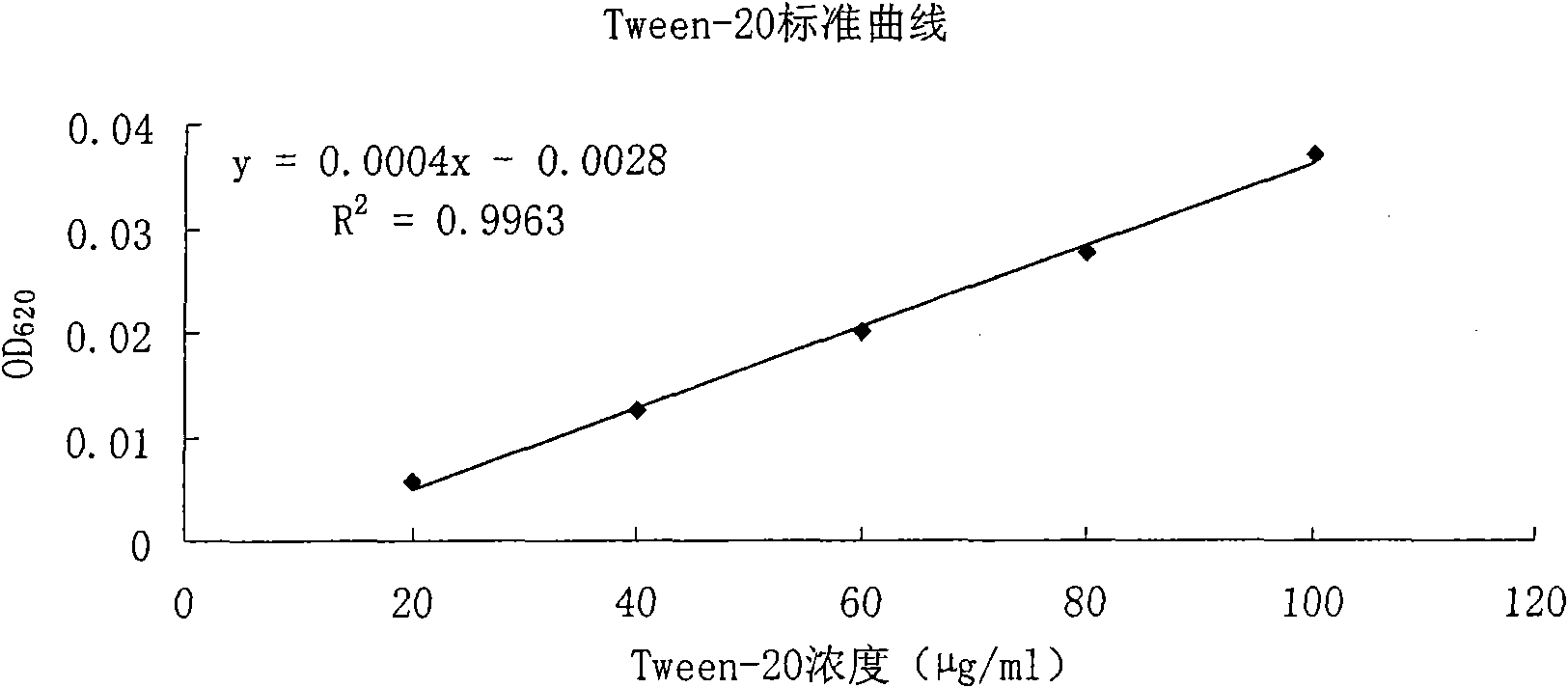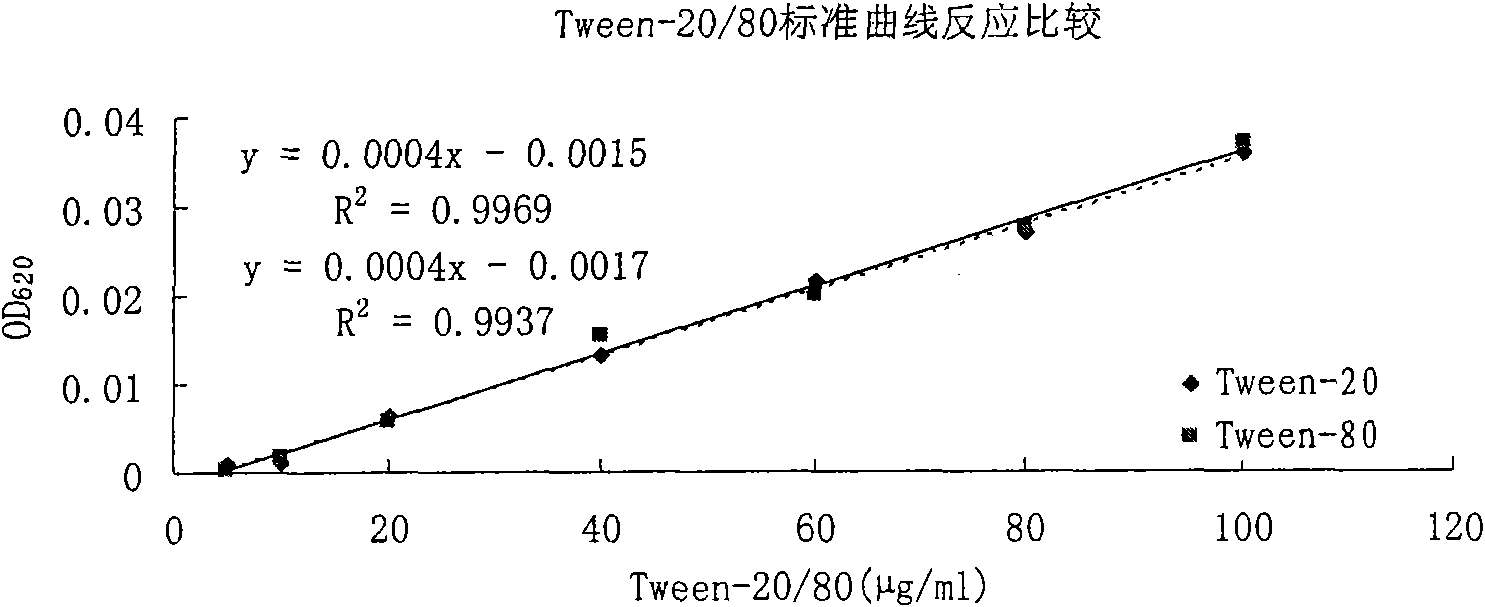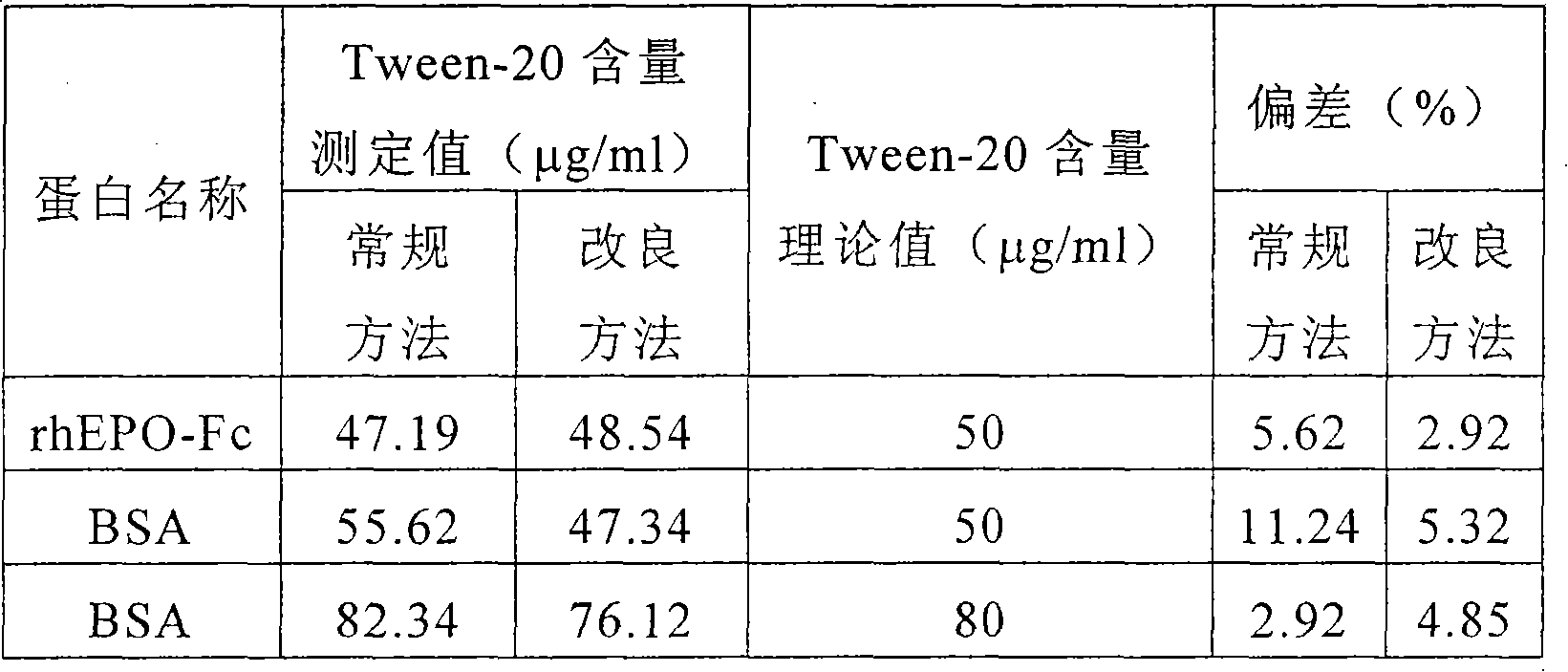Method for measuring polysorbate content in protein solution
A polysorbate and protein technology, which is applied in the biological field, can solve the problems of easy loss of samples, long time, affecting the experimental results, etc., and achieves the effect of overcoming the long detection time interval, simple operation and good repeatability.
- Summary
- Abstract
- Description
- Claims
- Application Information
AI Technical Summary
Problems solved by technology
Method used
Image
Examples
Embodiment 1
[0028] Determination of Tween-20 (polysorbate 20) content in embodiment 1 recombinant human erythropoietin (Fc) fusion protein [rhEPO-Fc] injection
[0029] The rhEPO-Fc injection (Lot. 20060301) was used for testing, and the content of Tween-20 in the injection was 0.01%, ie about 100 μg / ml. The test steps are:
[0030] (1) Take 0, 20, 40, 60, 80, and 100 μl of Tween-20 standard solution (1mg / ml) into glass test tubes with stoppers, and add water to 1ml;
[0031] (2) Add 2ml of chloroform and 3ml of ammonium thiocyanate cobaltammonium aqueous solution to each tube (weigh 6.0g of cobalt nitrate and 40.0g of ammonium thiocyanate, add water to dissolve and dilute to 200ml), mix well; shake fully at intervals of 15 minutes Mix once, 4 times in total;
[0032] (3) Stand in a 60°C water bath for 10 minutes;
[0033] (4) Remove the upper layer solution with a fine pipette, and take the lower layer solution to measure OD 620 Value, and the concentration as the abscissa, the corre...
Embodiment 2
[0039] Comparative test of embodiment 2 conventional method and improved method
[0040]Take rhEPO-Fc injection (Lot.20060301) (containing 50 μg / ml Tween-20) and self-prepared 100 μg / ml BSA (bovine serum albumin) solution (containing 50, 80 μg / ml Tween-20 respectively) as test samples. The improved method is implemented according to Example 1. The general method is as follows:
[0041] (1) Take 1.0ml of the above samples respectively in a plugged centrifuge tube, add 5ml of ethanol-sodium chloride saturated solution, shake well, and centrifuge at 3000rpm for 10 minutes;
[0042] (2) Take the supernatant, then carefully wash the tube wall with 1.0ml ethanol-sodium chloride saturated solution, combine the washing solution and the supernatant, and centrifuge at 3000rpm for 10 minutes;
[0043] (3) Take the supernatant and put it in a 55°C water bath, blow it with a hair dryer, concentrate it to 0.1-0.5ml, add 1ml of water to dissolve;
[0044] (4) Add 2.0ml of dichloromethane ...
Embodiment 3
[0051] The impact of embodiment 3 different proteins on the determination of polysorbate content
[0052] Different concentrations of rhEPO-Fc, recombinant human lymphocyte-associated factor (Fc) fusion protein [rhLFA-Fc], recombinant human parathyroid hormone 1-34 [rhPTH1-34], Exendin-4 and BSA were detected by the improved method above. Effect of solution on determination of polysorbate content. The experimental results are shown in Table 3.
[0053] Table 3: Comparison of polysorbate content determination results in several protein solutions
[0054]
protein name
(μg / ml)
Tween-20 content
Theoretical value (μg / ml)
Tween-20 content
Measured value (μg / ml)
deviation
(%)
rhEPO-Fc
50
50
48.63
2.74
rhEPO-Fc
100
50
45.68
8.64
rhEPO-Fc
150
50
Unable to sample for detection
-
rhLFA-Fc
50
50...
PUM
| Property | Measurement | Unit |
|---|---|---|
| Molecular weight | aaaaa | aaaaa |
Abstract
Description
Claims
Application Information
 Login to View More
Login to View More - R&D
- Intellectual Property
- Life Sciences
- Materials
- Tech Scout
- Unparalleled Data Quality
- Higher Quality Content
- 60% Fewer Hallucinations
Browse by: Latest US Patents, China's latest patents, Technical Efficacy Thesaurus, Application Domain, Technology Topic, Popular Technical Reports.
© 2025 PatSnap. All rights reserved.Legal|Privacy policy|Modern Slavery Act Transparency Statement|Sitemap|About US| Contact US: help@patsnap.com



